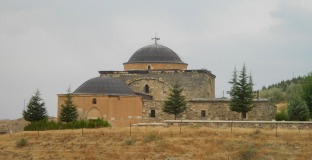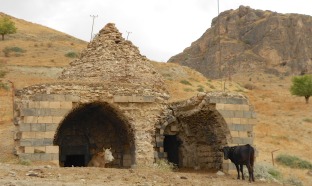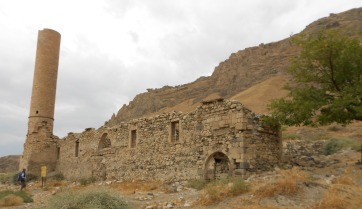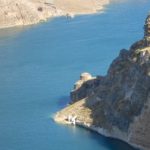Erol was a cheery chappie. I’d been assigned him as a driver when I ventured into the Belediye in Palu, near Elazığ, to ask for advice on getting to the ruins of the old settlement. As we bumped along the dirt track leading into the hills above the modern town he described how the hillside beneath the old Urartian fort high up on the rocks had once been covered in shops and houses, a town at least as big as the one that now existed below it on the shores of the Murat Nehri (river).
Almost at once we came to a small mosque, described as a mescid despite its size, that had been completely restored. Erol had seen the picture of a large ruined church in my guide to Elazığ that had brought me here in the first place. “That’s an old picture,” he had said. Then, rather sheepishly: “The stones have been taken away to rebuild the mosque.”
Not altogether surprisingly given its isolated location the mosque-mescid turned out to be locked. Erol grew quite jittery. Clearly this offended against his sense of misafirperverlik (hospitality), vital when driving around a rare yabancı (foreign) visitor. To ease his discomfort I wandered around the back of the building, intending to admire the view but instead coming across a waist-high opening that led into a tomb containing half a dozen graves draped with colourful cloths. A ladder trailed through the middle of the chamber and up to the window, a strange intrusion. “It was broken. They needed to fix it,” said Erol, following me in, then pausing to pray. No word on why it couldn’t have been cleared away again afterwards though.
A little further along the road we spotted the first of the ruins, those of the old Merkez Cami (Central Mosque) built of sand-coloured stone that, at this time of year, when the surrounding grass had died back in the scorching summer heat, blended almost perfectly into the background. Many years ago someone in authority had taken the trouble to have all the sights of Eski Palu labelled with yellow signboards. From this I learnt that the old mosque was not actually all that old despite its rooflessness. It had been built in the 19th century, long after the much smaller Alacalı mescid that stood beside it flaunting a chequerboard façade.
Now it was my turn to feel uncomfortable for Erol. From the double iwan fronting the mescid a pair of cows gazed out at us in big-eyed surprise. Inside, a third beast scratched its neck thoughtfully against the side of the mihrab.
“There’s no congregation now,” I hastened to say. “Buildings need to be used. At least it keeps them warm in winter.”
We drove on round the base of the rock where the ruins of two more mosques, the Büyük (Big) and Küçük (Small) Camis, and a large hamam hinted at the size of the lost settlement. Here nothing was locked. Here there were no beasts in residence so neither of us needed to feel uncomfortable.
On a bluff in front of the ruins a Caterpillar stood sentinel. “They’re clearing the ground for a cultural centre,” Erol said and at once a watchman named Ahmet came to join us. He had piercing blue eyes that seemed quite at odds with our middle-Anatolian setting. “It will be a hotel and restaurant,” he told me. “It will have superb views – the river, the rock, the ruins.”
I could feel my heart sinking as I remembered the new Harput Hünkar Konağı, looming up on the rock opposite Harput Castle and jostling it for prominence. It wasn’t that it was a bad building exactly. It was just that it was so in your face, so domineering, so utterly intrusive.
“It won’t be concrete, will it? Not a large concrete building?”
Ahmet grinned. “No,” he reassured me. “Kerpiç (adobe).”
 I’m not sure that I believed him but we still had the church that was pictured in my guidebook to find. It lurked just a little further down the hill towards the river, all alone in its mountain setting. The guide described it as Byzantine but I had my doubts. Such tiny traces of fresco and writing as survived on the arch framing the apse were clearly modern. Armenian, I presumed.
I’m not sure that I believed him but we still had the church that was pictured in my guidebook to find. It lurked just a little further down the hill towards the river, all alone in its mountain setting. The guide described it as Byzantine but I had my doubts. Such tiny traces of fresco and writing as survived on the arch framing the apse were clearly modern. Armenian, I presumed.
Further down the hill towards the river a large rock stood in the grounds of a goat farm. According to the sign, it had once been inhabited by the Urartians so through the farmyard we dashed with me doing my best not to wince at all the rubbish strewn around. Such Urartian traces as survived were hard to pick out. Instead I got a magnificent view of the river and the newly restored Ottoman bridge running alongside the railway bridge across it.
Back in town I waved goodbye to Erol. Palu is not the sort of place to attract many visitors and people were still talking about the two Japanese men who’d arrived there on a motorbike not so long ago as if they were Shackleton and co. Come to think of it, they’re probably still talking about the strange Englishwoman who showed up there last year as I write this. 
Written: March, 2015

